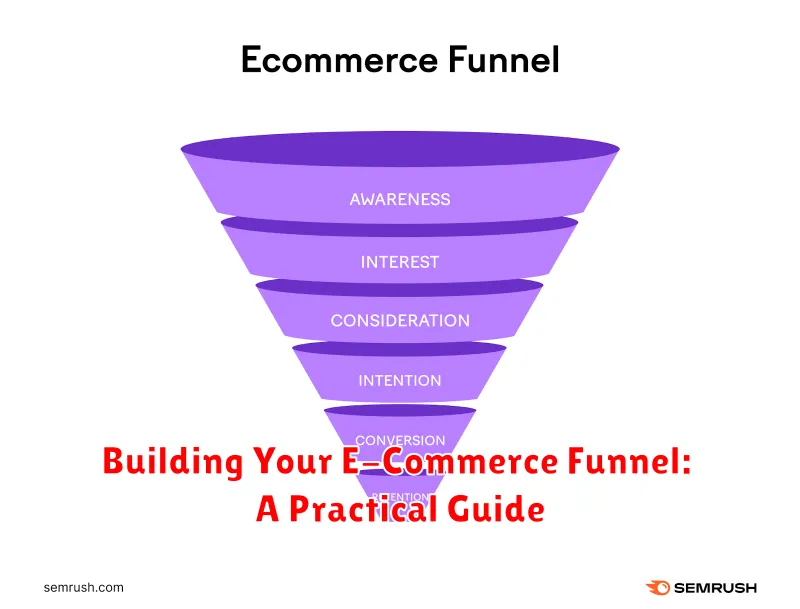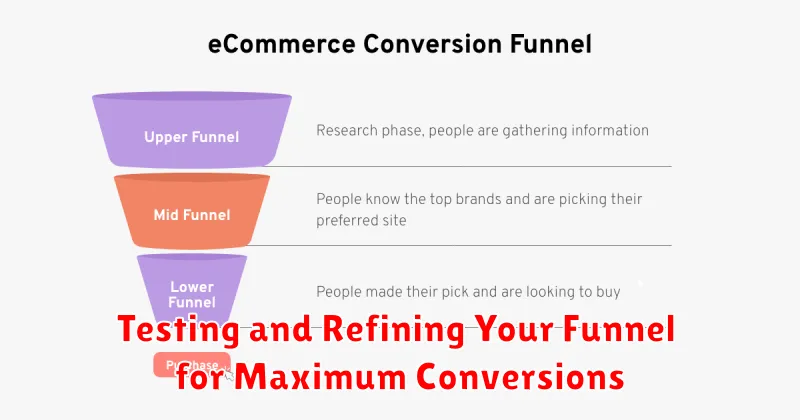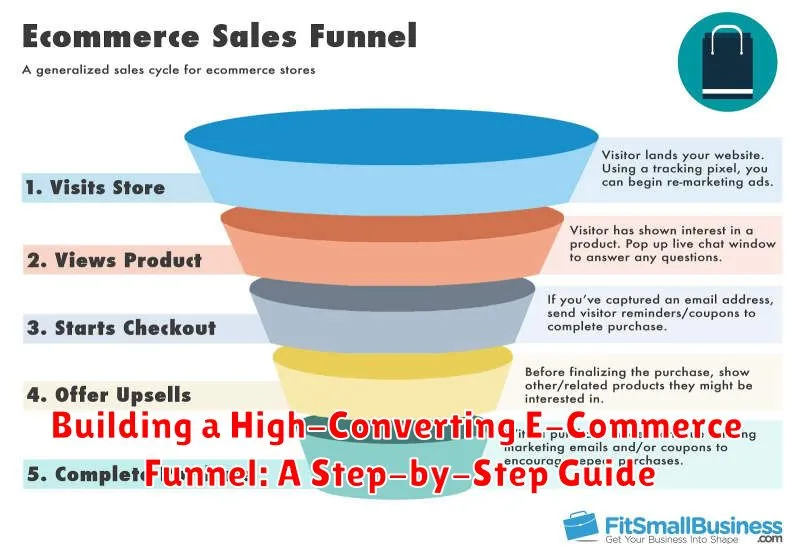In today’s competitive digital landscape, a high-converting e-commerce funnel is essential for online business success. This comprehensive guide provides a step-by-step approach to building a sales funnel that effectively attracts, engages, and converts visitors into paying customers. Learn how to optimize each stage of your funnel, from awareness and interest to desire and action, maximizing your return on investment and driving sustainable growth. We’ll cover key strategies for enhancing user experience, increasing conversion rates, and ultimately, boosting your bottom line.
Whether you are launching a new online store or seeking to improve an existing one, this guide offers practical advice and actionable insights. Discover how to effectively leverage e-commerce marketing strategies to build a robust and high-converting funnel. We will explore the core principles of funnel optimization, including target audience identification, compelling content creation, effective product presentation, and streamlined checkout processes. By implementing these strategies, you can transform your e-commerce platform into a powerful sales engine.
What is an E-Commerce Funnel?
An e-commerce funnel is a visual representation of the customer journey toward purchasing a product or service online. It describes the various stages a potential customer goes through, from initial awareness to final purchase. Think of it as a funnel because a large number of potential customers enter at the top, and the number gradually decreases as they move through each stage.
The purpose of understanding and optimizing your e-commerce funnel is to increase conversions. By identifying potential bottlenecks or drop-off points within the funnel, businesses can implement targeted strategies to improve the customer experience and ultimately drive more sales. Each stage presents unique opportunities for engagement and optimization.
Understanding the Stages of a Typical E-Commerce Funnel
A typical e-commerce funnel can be visualized as a series of steps that a customer takes, from initial awareness to finally completing a purchase. Understanding these stages is crucial for optimizing conversions at each point.
Generally, a standard e-commerce funnel consists of four primary stages:
- Awareness: The customer becomes aware of your brand or product. This might be through social media, search engine results, or advertising.
- Interest: The customer shows interest in your offerings and begins to research more, perhaps by visiting your website or reading product reviews.
- Decision: The customer decides to make a purchase. Factors influencing this stage include pricing, shipping options, and available payment methods.
- Action: The customer completes the purchase. A smooth checkout process is essential here to minimize cart abandonment.
While this is a simplified representation, it provides a framework for understanding the customer journey. Each stage requires a specific approach to maximize customer engagement and drive them towards the next step.
Key Metrics for Measuring Funnel Performance
Tracking the right metrics is crucial for understanding your e-commerce funnel’s effectiveness. These metrics provide insights into where users are dropping off and where improvements can be made. By monitoring these key performance indicators (KPIs), you can make data-driven decisions to optimize your funnel for higher conversions.
Essential Metrics:
- Conversion Rate: This is the percentage of visitors who complete a desired action, such as making a purchase. It’s calculated by dividing the number of conversions by the total number of visitors.
- Cart Abandonment Rate: This measures the percentage of users who add items to their cart but leave without completing the purchase.
- Average Order Value (AOV): This is the average amount spent per order. Increasing AOV can significantly impact revenue.
- Customer Lifetime Value (CLTV): CLTV predicts the total revenue a business expects from a single customer over their entire relationship. It helps understand the long-term value of acquiring a customer.
- Bounce Rate: The percentage of visitors who leave a page without interacting with it. A high bounce rate, especially on landing pages, can indicate issues with page relevance or user experience.
Strategies for Optimizing Each Stage of the Funnel
Optimizing each stage of your e-commerce funnel is crucial for maximizing conversions. Here’s a breakdown of strategies for each stage:
Awareness Stage:
Focus on expanding your reach. Employ targeted advertising campaigns on platforms frequented by your ideal customer. Content marketing, particularly SEO-driven blog posts and engaging social media content, can also attract potential customers.
Interest Stage:
Once you’ve captured attention, nurture interest with high-quality content. Offer valuable resources like ebooks, webinars, or product demos to showcase your expertise and build trust.
Desire Stage:
Fuel desire by highlighting the unique benefits of your products. Customer testimonials, product reviews, and compelling product descriptions can effectively persuade potential buyers.
Action Stage:
Make the purchase process as seamless as possible. A clear call to action, streamlined checkout, and various payment options can significantly reduce cart abandonment. Offering limited-time promotions can also incentivize immediate purchases.
Building Your E-Commerce Funnel: A Practical Guide

This section provides a practical framework for constructing your own high-converting e-commerce funnel. Follow these steps to create a robust and effective sales process.
1. Define Your Target Audience
Understanding your ideal customer is paramount. Identify their demographics, needs, and online behavior. This knowledge will inform every aspect of your funnel.
2. Choose Your E-Commerce Platform
Select a platform that aligns with your business needs and technical capabilities. Consider factors like scalability, integrations, and user experience. A robust platform is the foundation of your funnel.
3. Craft Compelling Content
Engage potential customers with high-quality content that addresses their pain points and showcases your products’ value. This could include blog posts, videos, or social media updates.
4. Design a Seamless Checkout Process
Minimize friction during checkout by offering multiple payment options and simplifying form fields. A smooth checkout experience is crucial for converting leads into paying customers.
5. Implement Analytics and Tracking
Monitor key metrics to identify areas for improvement. Data-driven optimization is essential for maximizing your funnel’s effectiveness.
Choosing the Right Tools and Technologies
Selecting the right tools and technologies is crucial for building a high-converting e-commerce funnel. Your choices will directly impact your ability to track, analyze, and optimize every stage of the customer journey.
E-commerce Platforms: Choose a platform that aligns with your business needs and offers robust features for managing products, inventory, and orders. Consider factors like scalability, integrations, and ease of use.
Analytics Platforms: Accurate data analysis is essential for understanding funnel performance. Implement analytics tools that provide insights into key metrics like conversion rates, bounce rates, and average order value.
Marketing Automation Tools: Automation can streamline various marketing tasks, such as email marketing, social media management, and personalized product recommendations. Choose tools that integrate seamlessly with your e-commerce platform and analytics tools.
A/B Testing Software: Continuously testing different elements of your funnel is key to optimization. A/B testing software enables you to experiment with different versions of your website and marketing materials to identify what resonates best with your target audience.
Testing and Refining Your Funnel for Maximum Conversions

Once your e-commerce funnel is established, the work doesn’t stop there. Continuous testing and refinement are crucial for maximizing conversions. This involves analyzing data, identifying areas for improvement, and implementing changes to optimize performance.
A/B testing is a powerful technique for comparing different versions of elements within your funnel. Test variations of your landing pages, calls to action, product descriptions, and checkout process. By analyzing the results, you can identify which variations perform best and implement them permanently.
Regularly analyze key metrics like conversion rates, bounce rates, and cart abandonment rates. These metrics provide valuable insights into user behavior and identify potential bottlenecks in your funnel. For example, a high cart abandonment rate could indicate issues with shipping costs or a complicated checkout process.
Use heatmaps and scroll maps to understand how users interact with your website. This visual data can reveal areas of interest and identify elements that are being ignored. Use this information to improve the layout and design of your pages to better guide users towards conversion.
Case Studies of Successful E-Commerce Funnels
Examining successful e-commerce funnels provides valuable insights for optimizing your own strategy. Let’s explore a few examples.
Case Study 1: Fashion Brand Utilizing Personalized Recommendations
A fashion e-commerce brand implemented a funnel focusing on personalized product recommendations. By analyzing browsing history and purchase data, they tailored product suggestions within the funnel, resulting in a 15% increase in average order value.
Case Study 2: Electronics Retailer Streamlining Checkout
An electronics retailer identified cart abandonment as a key challenge. They streamlined their checkout process by reducing the number of steps and offering guest checkout, leading to a 10% reduction in cart abandonment and a 7% increase in conversions.
Case Study 3: Subscription Box Service Leveraging Social Proof
A subscription box service incorporated social proof elements, such as customer testimonials and influencer endorsements, within their funnel. This strategy built trust and credibility, resulting in an 8% increase in free trial sign-ups.

